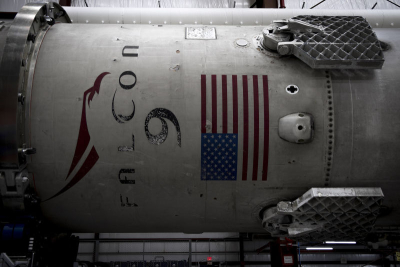
The competition heats up: In an Instagram post, Elon Musk has revealed that the Falcon 9 first stage that successfully landed vertically after launch is in its hanger and is essentially undamaged.
Elon Musk: “Falcon 9 back in the hangar at Cape Canaveral. No damage found, ready to fire again.”
Musk’s post included a higher resolution version of the picture on the right, showing a close-up of the stage near its top. This image reveals that, despite some minor paint damage and dirt, this section of the stage does appear whole and ready to go. Even the landing fins are folded and appear undamaged.
Musk’s post also suggests that the stage is ready for its first post-launch test firing, which underlines how unique this opportunity is. No one has ever had a functioning first stage available for testing after it had been launched and returned to Earth. Past assumptions (an important word) have always said that the stress of launch would damage it enough that it wouldn’t be cost effect to reuse it. SpaceX’s engineers now will have an opportunity to find out if that assumption was true or false. I strongly suspect they will find that this assumption was false, that it was used as a bugaboo by the small-minded to discourage just this kind of effort by SpaceX.
This article notes that Musk has previously said it costs $60 million to build the first stage, but only $200K to refuel it. Since SpaceX says it charges about $70 million per launch, that first stage is most of SpaceX’s cost for each launch. If the stage can reused later, the cost of later launches will thus plummet incredibly. Assume they can only reuse the stage once. Amortized over only two launches the cost is still cut by almost half. More importantly, the ability to reuse will be an incentive for them to build the stage right the first time, so that it can be reused multiple times.
I repeat: The importance of this breakthrough has not yet sunk in. It is going to change the entire aerospace industry and everything we do in space.
Update: I have corrected the post above, which originally incorrectly stated that the picture showed the stage near its base.

